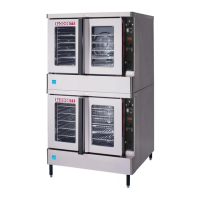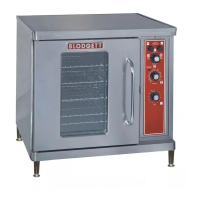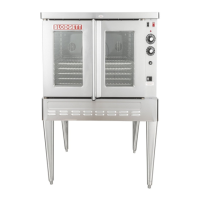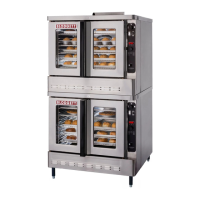MARK V
2-3
CE APPROVED COOK ONLY - 33339 REV C
Component Reference
NOTE: Refer to FIGURE 2 page 2-4 for compoĆ
nent locations.
1. MODE SELECTOR SWITCH
2. COOK TIMER
3. DOOR SWITCH
4. TEMPERATURE CONTROL BOARD
5. AXIAL FAN
6. CONVECTION FAN MOTOR
7. TEMPERATURE PROBE
8. SOLID STATE POTENTIOMETER
9. CENTRIFUGAL SWITCH
10. HIGH LIMIT SWITCH
11. ELEMENT CONTACTOR
12. COOK LIGHT
13. HEATING ELEMENTS
14. 50 WATT LAMPS
15. LIGHT SWITCH
16. TIMER MOTOR
17. BUZZER
Operation
1. Turn the mode selector switch (1) to the cook
position. Power goes to terminal #1 of the
cook timer (2), one side of the door switch (3),
terminal #8 of the temperature control board
(4) and the axial fan (5).
2. If the doors are closed the door switch (3)
should also be closed sending power to termiĆ
nal #6 of the temperature control board (4)
and to the convection fan motor (6).
NOTE: This motor has a built in centrifugal
switch (9) that closes when the motor
reaches full speed. If found faulty do
not bypass, the whole motor should be
replaced.
3. On a call for heat from the temperature control
circuit, a circuit is completed between termiĆ
nals #6 and #7 of the temperature control
board (4).
NOTE: The temperature control circuit conĆ
sists of the temperature probe (7), the
temperature control board (4) and the
solid state potentiometer (8).
Power is sent out of terminal #7 to one side of
the centrifugal switch (9). If the convection fan
motor (6) is at full speed the centrifugal switch
(9) closes sending power to one side of a high
limit switch (10), if the high limit is closed then
power will be sent to one side of the contactor
(11) and an indicator light (12). When the conĆ
tactor closes the heating elements (12) power
up.
4. The 50 watt lamps (13) only receive power when
the light switch (14) is activated.
5. When the cook timer (2) is set for a time a cirĆ
cuit is made between terminals #1 and #2
powering up the timer motor (15). At the expiĆ
ration of the set time the switch in the cook timĆ
er (2) toggles from 1-2 to 1-4 powering up
the buzzer (16).
NOTE: Put the timer in the home position to siĆ
lence the buzzer.
NOTE: Turn the mode selector switch to cool
down to bypass the door microswitch. This
allows the convection fan motor to operate
even when the doors are open.
NOTE: This oven may be converted from single to
three phase, however, contactors must be
changed due to the difference in amp
draw. Reference detail inset in FIGURE 2.
NOTE: Reference page 4-2 of the TroubleshootĆ
ing section for the resistive values of the
heating elements. The reading should be
taken in a cold state.

